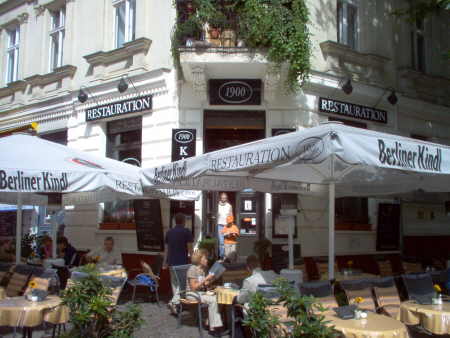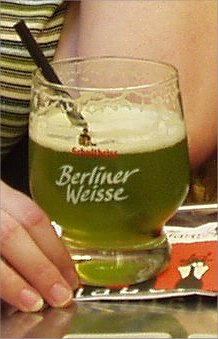German beer is great. Everything you’ve heard is true. But there are some aspects of it that I wasn’t expecting that I think are worth sharing.
The sponsorship issue. When you go to any reasonable bar in the US, you can expect to find 4-10 beers on tap, usually representing a pretty good variety. Some American pilsner megabrew, probably some imported British macrobrew (Guinness, Harp, etc) a local macrobrew (usually Anchor Steam around SF), and if you’re lucky, 1-6 local microbrews. Going to fancier beer bars results in more numerous and esoteric options.

In Germany, practically every bar is ‘sponsored’ by one of a few major macrobrews: Erdinger, Berliner, Paulaner, etc. This means (as far as I can tell) the bar gets free umbrellas, signs, maybe some furniture, glasses, tap equipment at a reduced rate. Think of the old convenience stores around the US with giant coke-logo with tiny text underneath with the store name. The result of this sponsorship is that for some period of time–years, it seems–the bar is obligated to serve beers only from this brewery. So, at most bars, you can get one (usually quite good) variety of beer, probably a pilsener and maybe also a Hefewiessen, but that’s it. You specify the type of beer, and the brewery is determined by the sponsorship. You want another kind of beer? Switch your bar.
There are a few Irish pubs around that operate in the US-style, and so you can get several types of German beer there. Also, we’ve found two actual breweries, who tend to be independent and serve not only the house brews but several selections from local macrobrews.
The problem with good macrobrews. In the US, there are three huge macrobrews: Budwieser, Miller, and Coors. As far as I can tell, the beer from these three tastes more or less identical and is… not too popular among enthusiasts. This is probably because the beer is brewed mostly from rice syrup, not malt (i.e., grain), meaning it would not even be legal to sell it as beer in Germany (here, beer can contain only water, malt, hops, and yeast). Nonetheless, the vast majority of the beer Americans drink is from one of the big three. The result is that anyone looking for something else has to look at smaller breweries… from smaller but still national breweries like Sam Adams all the way down to boutique breweries like Stone that make comparatively minute quantities.
Here in Deutschland, though, the big brews are good. Like, really good. I still haven’t gotten tired of getting half a liter of Paulaner Hefe-Wiessbier or Franziskaner Hefe-Weisse Dunkel or a lighter Krombacher Pils, all for under 3 euros, less than you’d pay for a skimpy pint in the US. But the good macrobrews serve to block the proliferation of microbrews–why bother seeking out and trying a micro when all the beer around you is so decent? Hence, Germany has only a few microbrews, usually operating out of a single brew-pub. We have found a couple of them though, and the beer is quite good. But not really noticeably better than that you can get at any bar, hence the problem. So variety is lacking a bit, but the average quality is so high and the common beer is unfamiliar enough that I don’t really mind.
Strange concoctions. The last, and probably most unexpected, thing I’d like to mention is what they mix beer with and drink like it’s normal. Before we came, we were warned about the Berliner Wiesse weak beer mixed with fruit syrup. Although it’s indigenous, apparently only tourists drink it, which made sense to me, because why would you spoil good beer like that?

What blew me away is what people do drink. Exhibit A: Radler. This is beer mixed with some sweetened citrus, usually lemonade, drunk on hot afternoons or actually whenever if you’re a teenager. This stuff is so popular that you can even get it premixed, bottled in stores. Imagine my surprise when I spotted a classic German brew, Warsteiner, premixed in Lemon and Orange flavors! I’ve tried it… I can’t quite handle sweet+beer, but Leslie says she likes it. Exhibit B: Diesel. This is beer mixed with coke. I drank a whole one of these… it was pretty gross, but seems also to be quite popular (Warsteiner markets this mixture in bottles as well). Leslie has a theory that the younger crowd (drinking age here is 16, and unenforced) use these mixtures as training beers until they are ready for the real thing. Who knows.
Drinking in the streets. The last thing I want to mention is drinking in the streets, which is totally legal here. It takes a while to get used to seeing people just strolling along with a jumbo pilsener in one hand, but then you start to wonder what the big deal is, and why we can’t do this in the US. I have to admit being able to sip a beer while waiting for the laundry to dry at the laundromat made it a much more pleasant experience.
So that’s what’s funny about beer here. We’ve made plans for trips to Barcelona, Amsterdam, and Prague with the first starting next Tuesday, so I’m sure there will be more to share on the travel front soon.
…meaning it would not even be legal to sell it as beer in Germany (here, beer can contain only water, malt, hops, and yeast)….
Actually, not true anymore. According to an actual German dude, this law became null and void when they joined the EU. That is why you can now buy bottles of fruity beer mixtures, the Boones Farm of Germany.
Oh, right! I guess I figured those mixtures weren’t actually called ‘beer,’ which made it ok to sell them. I guess at this point it makes sense to go the full length of internet diligence and wikipedia it:
So it looks like the rule has been out of commission since the 80’s. Long live rice beer.
If you ever make it to Seligenstadt, near Frankfurt am Main, you should check out my ancestors’ brewery: Glaabsbräu (http://www.glaabsbraeu.de/). Hope you’re having a good trip!
-Sophie
That’s right! I had forgotten about that completely. We certainly won’t miss it if we’re in that neighborhood.
Bryan: wiki is wrong on the “wheat beer” exception to Reiheitsgebot.
The law states that only MALT, WATER & HOPS were allowed (later yeast, because, of course, at the time it was written, yeast wasn’t allowed either because microbiology had not been invented). Wheat beers are made with MALTED wheat and malted barley, and was always allowed prior to the 1992 EU decision that opened up the German market to non-Reiheitsgebot brews. Malted rye, or any other grain, was also allowed.
Adjunct, or non-malted grains, were prohibited (such as used in nearly all North American macro-beers, usually rice or corn), along with any seasonings, fruits, preservatives, etc.
In fact, because of the rule, German Guinness is actually brewed with all-malt, and is therefore, not technically a stout…but it is delicious!